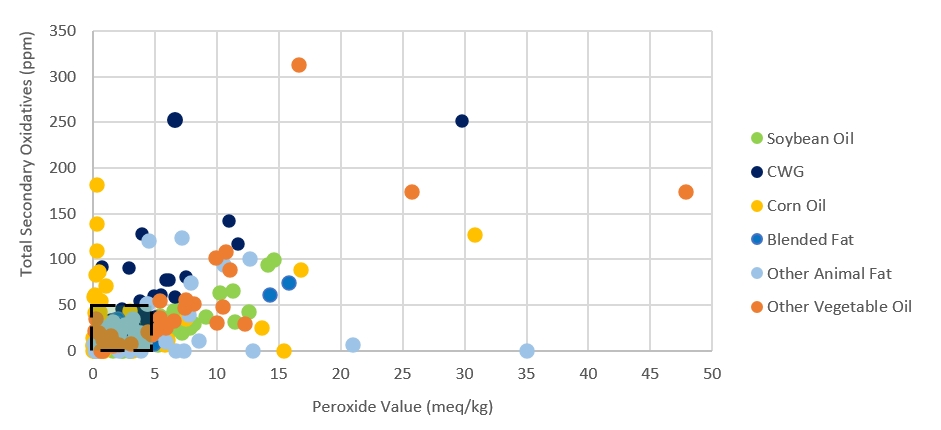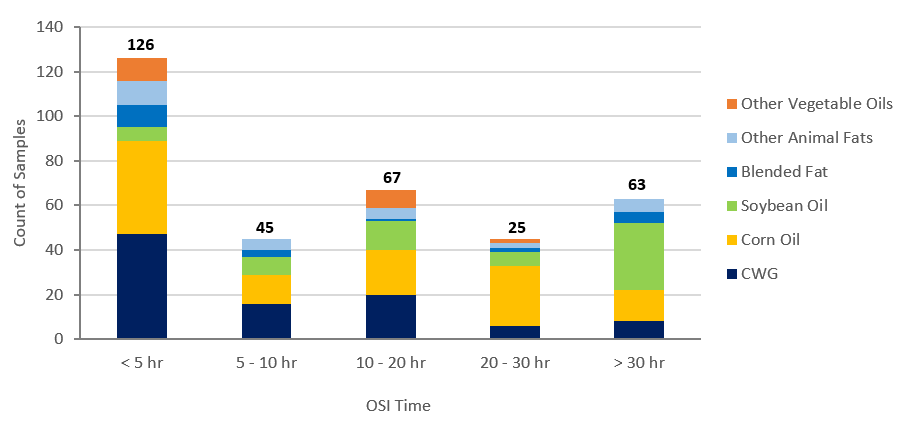You are viewing United States
- United States
- Canada
- Mexico
- South America
- EMENA
- Sub-Saharan Africa
- Russia
- South Asia
- Asia Pacific
- China
- Global
Choose Your Location:
- United States
- Canada
- Mexico
Popular Searches
- Animal Nutrition & Health
- Are Oxidized Lipids Impacting Your Animal’s Performance?
Are Oxidized Lipids Impacting Your Animal’s Performance?
Fats and oils – or lipids – are an essential energy-source in nearly every animal’s diet. However, lipid sources used in feed formulations today – vegetable oils, rendered animal fats, recycled restaurant grease and more – are not all created equal. Inconsistency in the properties of lipids, their quality and nutritional value are common concerns for producers. Then, in addition to that baseline variability, there are many environmental and biochemical factors that conspire against high-quality lipids, increasing their susceptibility to oxidation – a key source of decreased fat and oil quality.
What is oxidation costing you?
Oxidation is an irreversible process in which fatty acids are destroyed, thereby reducing the energy supply and nutritional quality of the diet. During the process of oxidation, degradation products – peroxides and secondary oxidative molecules – are produced at different stages. These toxic molecules in oxidized lipids negatively impact feed palatability, chip away at animal health and spur immunity and gut health problems that can have impacts beyond the feeding of that compromised fat.1
So, what does this mean? Simply put, when it comes to maximizing lipid quality, avoiding oxidation altogether is critical. For producers, monitoring the quality of incoming fat sources is the primary step in effective fat management. However, it’s also important to understand and properly evaluate the quality and nutritional value of lipids, including their oxidative status, when formulating dietary rations.
Evaluating the oxidative status of commercial lipids
To help producers understand how oxidation may impact their lipids’ quality, Kemin offers its customers the ability to analyze their fat and oil samples for select oxidative parameters. Since 2018, Kemin Customer Laboratory Services (CLS) has analyzed more than 390 fat and oils samples to estimate 1) the current state of oxidation – based on peroxide value and secondary oxidatives (hexanal + 2,4-decadienal) – and 2) the potential for future oxidation, measured by oxidative stability index (OSI). These measurements provide insights into oxidation risks which could lead to reduced animal efficiency, thereby impacting your bottom line. The summary of the CLS testing results are below.2
The variability of the current state of oxidation of fats and oils is shown in Figure 1. As a general guideline, fats and oils should contain a peroxide value (PV) less than 5 meq/kg and a total secondary oxidative value less than 50 ppm.3 This is indicated in Figure 1 by the shaded box. Of the samples that exceeded general guidelines, soybean oil and other animal fats tended to show elevated PV while choice white grease (CWG) and other vegetable oil often had elevated PV and secondary markers.

Figure 1. Peroxide value and total secondary oxidatives for fat and oil samples analyzed by Kemin CLS from January 2018 – September 2020 (n=392). CWG = choice white grease.
Figure 2 shows the potential for future oxidation of fats and oils measured by OSI. A longer OSI time, generally, represents a delay in onset of oxidation. Sample OSI times ranged widely from 0.2 to 144 hours. Overall, 50% of samples had an OSI time <10 hours, which may indicate enhanced susceptibility of these lipids to future oxidation.

Figure 2. Oxidative stability index (OSI) of fat and oil samples (n=346) analyzed by Kemin CLS from January 2018 – September 2020. The number above each column represents the total number of samples within each OSI time range. CWG = choice white grease.
Summary
As you can see, significant variability in the current oxidative status and potential for future oxidation of lipids exists. So, with all this variability among lipids, how can you avoid oxidation risks and help optimize your animal performance? Antioxidants are often the key. Antioxidants sacrifice themselves to quench free radicals, thus protecting fats and oils from irreversible oxidation. Common antioxidants include:
- Butylated hydroxytoluene (BHT)
- Butylated hydroxyanisole (BHA)
- Tert-butylhydroquinone (TBHQ)
- Propyl gallate
- Ethoxyquin
- Tocopherols
When using an antioxidant, it’s important to remember that it cannot reverse oxidation that has already occurred. Additionally, choosing the right antioxidant for your operation is essential. For example, research has shown that TBHQ and propyl gallate are more effective for vegetable oils; whereas, BHA and BHT are most effective when used in saturated animal fats.4,5
For more information on how liquid antioxidant systems – such as RENDOX® – can help protect your fats and oils from oxidation, visit kemin.com/RENDOX.
References
1Shurson, J. and B. Kerr. Fat, oxidation and the swine diet. National Hog Farmer, July 19, 2018.
2Evaluation of the variability in oxidative status of fats and oils used in livestock and poultry diets in North America, TL-20-18837.
3Verleyen, T. 2010. Oxidation key issue in use of oils and fats for feed, https://www.allaboutfeed.net/Nutrition/Raw-Materials/2010/2/Oxidation-key-issue-in-use-of-oils-and-fats-for-feed-AAF011469W/, accessed on October 28, 2020.
4Budilarto, E.S. and Kamal-Eldin, A. 2015. The supramolecular chemistry of lipid oxidation and antioxidation in bulk oils. Eur. J. Lipid Sci. Technol., 117:1095-1137.
5Comparative antioxidant efficacy of the antioxidants BHA, BHT, MTBHQ and ethoxyquin, BB-03-00649.
Have a Question?
If you have a question about our products or services, or just want more information, fill out the form below and someone on our team will be in contact with you.
- California Residents
- California Supply Chain Act
- Canada Forced Labor and Child Labor Report
- Email Disclaimer
- GDPR Personal Data Addendum
- General Terms & Conditions for Vendors
- Global Environmental Policy Statement
- Indirect Cost Estimates
- Kemin Terms & Conditions
- Modern Slavery Act Transparency Statement
- Privacy Policy
- Sitemap
- Change Cookie Consent
- Animal Welfare Statement
© Kemin Industries, Inc. and its group of companies All rights reserved. ® ™ Trademarks of Kemin Industries, Inc., USA
Certain statements may not be applicable in all geographical regions. Product labeling and associated claims may differ based upon government requirements.
Thank you for visiting Kemin.com.
Your questions and feedback are important to us. Let us know how we can help you learn more about Kemin, our products, our services or our website.
Interested in starting a career with Kemin?
